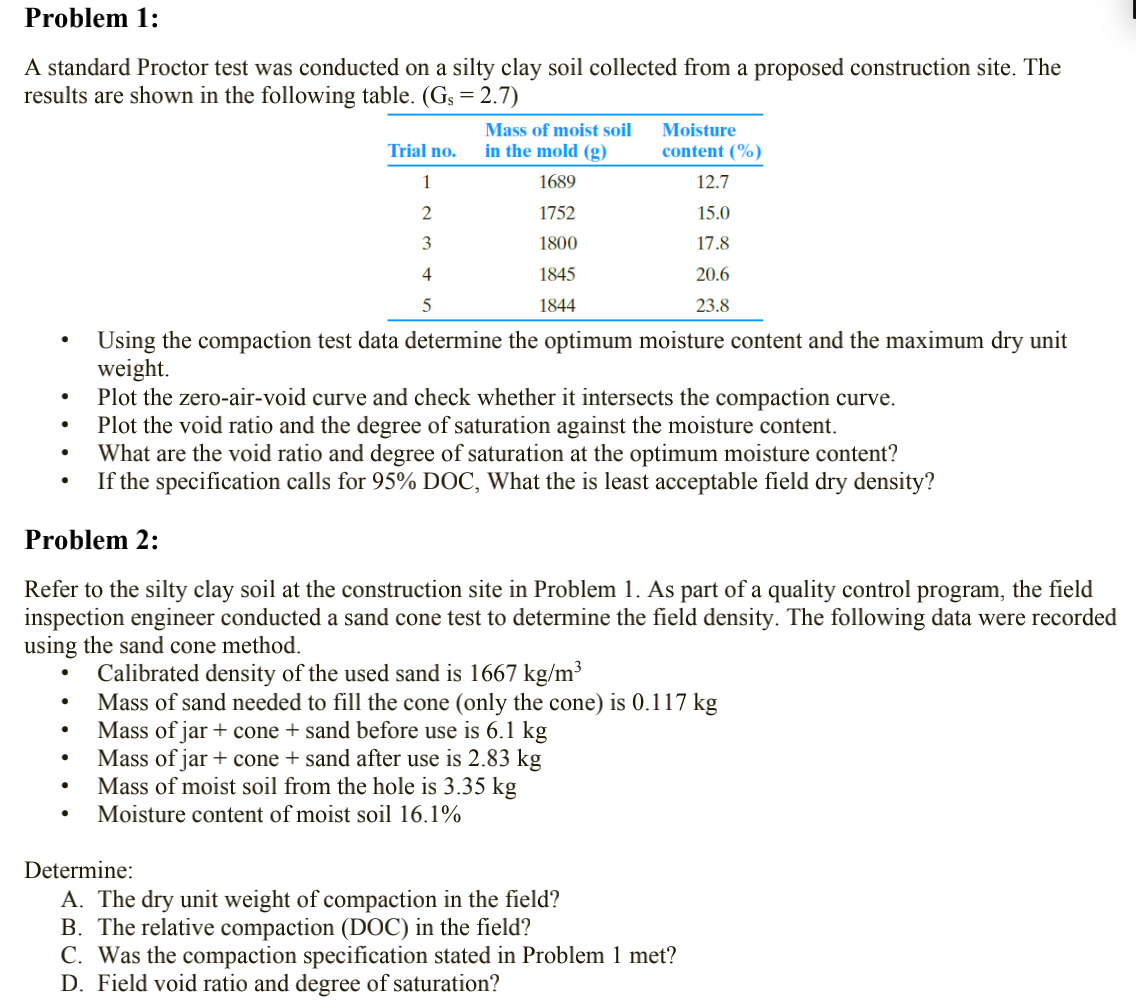Refer to the silty clay soil at the construction site in Problem 1. As part of a quality control program, the field inspection engineer conducted a sand cone test to determine the field density. The following data were recorded using the sand cone method. Calibrated density of the used sand is 1667 kg/m³ Mass of sand needed to fill the cone (only the cone) is 0.117 kg Mass of jar + cone + sand before use is 6.1 kg Mass of jar + cone + sand after use is 2.83 kg Mass of moist soil from the hole is 3.35 kg Moisture content of moist soil 16.1% Determine: A. The dry unit weight of compaction in the field? B. The relative compaction (DOC) in the field? C. Was the compaction specification stated in Problem 1 met?
Refer to the silty clay soil at the construction site in Problem 1. As part of a quality control program, the field inspection engineer conducted a sand cone test to determine the field density. The following data were recorded using the sand cone method. Calibrated density of the used sand is 1667 kg/m³ Mass of sand needed to fill the cone (only the cone) is 0.117 kg Mass of jar + cone + sand before use is 6.1 kg Mass of jar + cone + sand after use is 2.83 kg Mass of moist soil from the hole is 3.35 kg Moisture content of moist soil 16.1% Determine: A. The dry unit weight of compaction in the field? B. The relative compaction (DOC) in the field? C. Was the compaction specification stated in Problem 1 met?
Fundamentals of Geotechnical Engineering (MindTap Course List)
5th Edition
ISBN:9781305635180
Author:Braja M. Das, Nagaratnam Sivakugan
Publisher:Braja M. Das, Nagaratnam Sivakugan
Chapter5: Soil Compaction
Section: Chapter Questions
Problem 5.15P
Related questions
Question
please solve problem 2

Transcribed Image Text:Problem 1:
A standard Proctor test was conducted on a silty clay soil collected from a proposed construction site. The
results are shown in the following table. (Gs = 2.7)
Mass of moist soil
in the mold (g)
Moisture
Trial no.
content (%)
1
1689
12.7
1752
15.0
3
1800
17.8
4
1845
20.6
1844
23.8
Using the compaction test data determine the optimum moisture content and the maximum dry unit
weight.
Plot the zero-air-void curve and check whether it intersects the compaction curve.
Plot the void ratio and the degree of saturation against the moisture content.
What are the void ratio and degree of saturation at the optimum moisture content?
If the specification calls for 95% DOC, What the is least acceptable field dry density?
Problem 2:
Refer to the silty clay soil at the construction site in Problem 1. As part of a quality control program, the field
inspection engineer conducted a sand cone test to determine the field density. The following data were recorded
using the sand cone method.
Calibrated density of the used sand is 1667 kg/m³
Mass of sand needed to fill the cone (only the cone) is 0.117 kg
Mass of jar + cone + sand before use is 6.1 kg
Mass of jar + cone + sand after use is 2.83 kg
Mass of moist soil from the hole is 3.35 kg
Moisture content of moist soil 16.1%
Determine:
A. The dry unit weight of compaction in the field?
B. The relative compaction (DOC) in the field?
C. Was the compaction specification stated in Problem 1 met?
D. Field void ratio and degree of saturation?
Expert Solution
This question has been solved!
Explore an expertly crafted, step-by-step solution for a thorough understanding of key concepts.
This is a popular solution!
Trending now
This is a popular solution!
Step by step
Solved in 5 steps

Knowledge Booster
Learn more about
Need a deep-dive on the concept behind this application? Look no further. Learn more about this topic, civil-engineering and related others by exploring similar questions and additional content below.Recommended textbooks for you

Fundamentals of Geotechnical Engineering (MindTap…
Civil Engineering
ISBN:
9781305635180
Author:
Braja M. Das, Nagaratnam Sivakugan
Publisher:
Cengage Learning

Principles of Geotechnical Engineering (MindTap C…
Civil Engineering
ISBN:
9781305970939
Author:
Braja M. Das, Khaled Sobhan
Publisher:
Cengage Learning

Fundamentals of Geotechnical Engineering (MindTap…
Civil Engineering
ISBN:
9781305635180
Author:
Braja M. Das, Nagaratnam Sivakugan
Publisher:
Cengage Learning

Principles of Geotechnical Engineering (MindTap C…
Civil Engineering
ISBN:
9781305970939
Author:
Braja M. Das, Khaled Sobhan
Publisher:
Cengage Learning